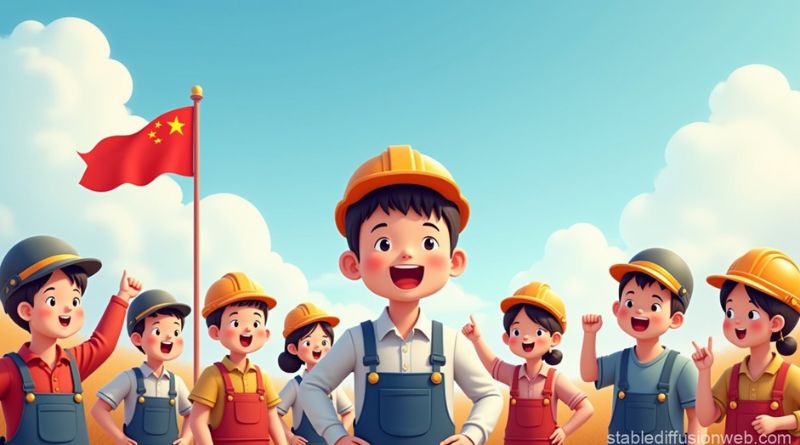As animation becomes increasingly global, Asian cartoon characters have taken a more prominent role in entertainment, offering cultural insights, relatable stories, and unique perspectives. From anime to Western animation, these characters represent various Asian cultures, languages, and traditions, celebrating diversity and bringing representation to screens worldwide. This article will explore notable Asian cartoon characters across popular media, the significance of their portrayal, and how they have contributed to the expanding world of animation.
Table of Contents
The Impact of Asian Representation in Cartoons
Asian cartoon characters bring unique storytelling and perspectives, allowing viewers to see themselves in mainstream media and understand different cultures. When done with authenticity and care, Asian representation in animation can bridge cultural gaps, promote understanding, and inspire audiences globally. For Asian viewers, seeing relatable characters in animated stories helps build confidence, pride, and validation in their cultural heritage. For non-Asian audiences, these characters often introduce diverse traditions and values that deepen cross-cultural appreciation.
In recent years, the focus on diversity and inclusion has led to more Asian characters in Western cartoons, inspired by anime, folklore, and real-life stories, while classic Asian characters in Japanese anime have become beloved worldwide. Let’s explore some standout Asian cartoon characters from both Western animation and Japanese anime.
Notable Asian Cartoon Characters in Western Animation
Western animation has increasingly introduced Asian characters, bringing to light various stories that resonate with global audiences. Here are a few beloved characters that have played a pivotal role in celebrating Asian culture and identity:
1. Mulan from Mulan
- Based on a Chinese folk tale, Mulan is a courageous, determined young woman who defies traditional gender roles to protect her family and country. Disney’s Mulan celebrates Chinese culture and the strength of Asian women, inspiring countless viewers.
2. Korra from The Legend of Korra
- Korra, the protagonist of The Legend of Korra, is from the Southern Water Tribe, inspired by Inuit and other Asian cultures. This series, which blends Asian cultural references with magic and martial arts, celebrates diverse Asian philosophies and identities.
3. Hiro Hamada from Big Hero 6
- As the young robotics genius and protagonist of Big Hero 6, Hiro is of Japanese descent. Set in the fictional San Fransokyo (a fusion of Tokyo and San Francisco), the film showcases Japanese culture and technology, portraying Hiro as both a brilliant inventor and a compassionate hero.
4. Jin and Sun Park from Avatar: The Last Airbender
- Though the entire Avatar series is filled with Asian cultural influences, Jin and Sun Park represent a nod to Korean culture within the show’s broader Asian-inspired world. The series’ rich themes are heavily drawn from East and South Asian cultures, philosophies, and aesthetics, which has helped it resonate with Asian and non-Asian audiences alike.
5. Connie Maheswaran from Steven Universe
- Connie, a close friend of the protagonist Steven, is of Indian descent. Her heritage is occasionally explored in the show, giving viewers insight into Indian traditions and values, especially through her interactions with her family.
Iconic Asian Characters in Japanese Anime
Japanese anime has been a global phenomenon, contributing widely to the world of animation. With strong narratives, complex characters, and culturally rich visuals, anime introduces countless memorable Asian characters.
1. Naruto Uzumaki from Naruto
- Naruto Uzumaki, a young ninja, is one of the most recognized anime characters globally. The series, rooted in Japanese folklore and values, explores themes of perseverance, friendship, and overcoming adversity, resonating with viewers worldwide.
2. Sailor Moon from Sailor Moon
- Usagi Tsukino, known as Sailor Moon, is a teenage girl who transforms into a magical superhero to protect Earth. The series is rich in Japanese cultural elements, and Usagi’s journey has inspired generations of young girls worldwide to be strong and compassionate.
3. Goku from Dragon Ball
- Goku is another globally iconic character who represents the strong, determined hero archetype often seen in Japanese culture. Dragon Ball, inspired by the Chinese novel Journey to the West, explores themes of honor, strength, and resilience, blending elements of martial arts with traditional Eastern philosophies.
4. Tohru Honda from Fruits Basket
- Tohru Honda, a sweet and optimistic character, showcases compassion and resilience. Through the show’s exploration of family curses and complex relationships, Fruits Basket delves into themes of acceptance, forgiveness, and self-discovery that reflect Japanese values.
5. Edward Elric from Fullmetal Alchemist
- Edward Elric, the protagonist of Fullmetal Alchemist, is a strong-willed alchemist on a journey to uncover powerful truths. The series deals with deep themes of loss, sacrifice, and ethics, offering audiences a philosophical look into the consequences of one’s actions.
Why Asian Representation in Cartoons Matters
Seeing authentic Asian representation in cartoons contributes to building self-esteem and a sense of belonging among Asian audiences. Additionally, it brings broader cultural awareness to non-Asian audiences, encouraging inclusivity and empathy. When cartoons take inspiration from real Asian traditions, values, and languages, they allow for a more authentic representation that resonates globally.
The increasing representation of Asian characters in Western animation also signals a positive trend of diversity in the entertainment industry. As more creators recognize the importance of inclusivity, audiences are treated to rich, nuanced stories that reflect a wide range of experiences, making animation a more representative and global art form.
Frequently Asked Questions (FAQs)
1. Why is representation of Asian characters important in cartoons?
- Representation allows viewers to see themselves and their cultures reflected in media, fostering self-esteem and a sense of belonging. For non-Asian viewers, it provides a window into other cultures, promoting inclusivity and understanding.
2. Which animated shows or films feature Asian characters?
- Many animated shows and films feature Asian characters, such as Mulan, The Legend of Korra, Avatar: The Last Airbender, Big Hero 6, and anime like Naruto, Sailor Moon, and Dragon Ball.
3. What themes are common in Asian-inspired cartoons and anime?
- Themes of honor, perseverance, friendship, family values, and cultural identity are often prominent. Many shows draw from folklore, philosophy, and martial arts, emphasizing resilience, unity, and ethical considerations.
4. Are there Asian characters in Western cartoons who have a significant cultural impact?
- Yes, characters like Mulan, Hiro from Big Hero 6, and Korra from The Legend of Korra have had significant cultural impacts, representing Asian traditions and values in a way that resonates with audiences worldwide.
5. How do Japanese anime characters represent Asian culture?
- Japanese anime characters often reflect Asian values, customs, and traditions, from family dynamics to respect for nature. Many anime series draw on Japanese folklore, martial arts, and philosophical ideas, bringing Asian culture to the forefront.
Conclusion
Asian cartoon characters are essential for celebrating diversity and fostering inclusivity in animation. From Western cartoons that introduce Asian cultures to Japanese anime that brings complex Asian characters and stories to life, these portrayals help bridge cultural divides and showcase the universal power of storytelling. As the animation industry continues to grow, the inclusion of Asian characters enriches the global animation landscape, ensuring that everyone can see themselves represented in the art form they love.






